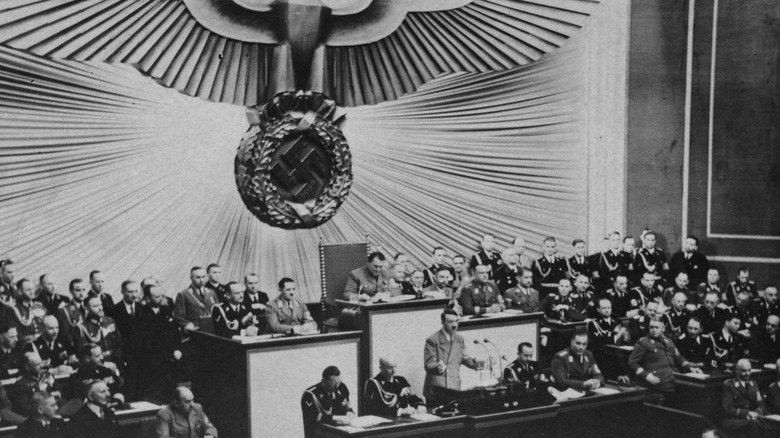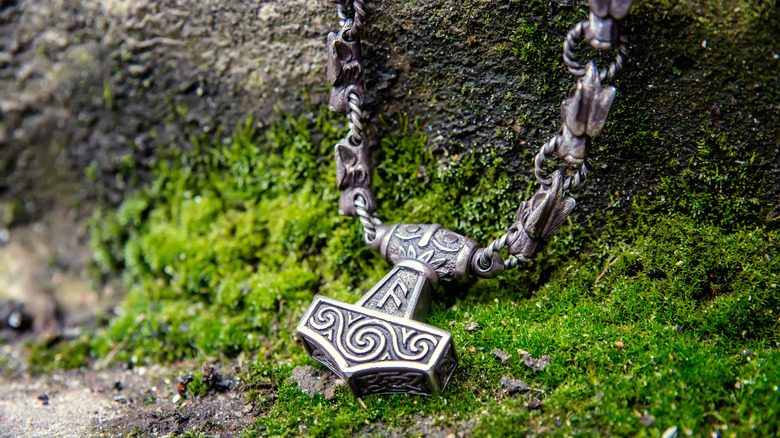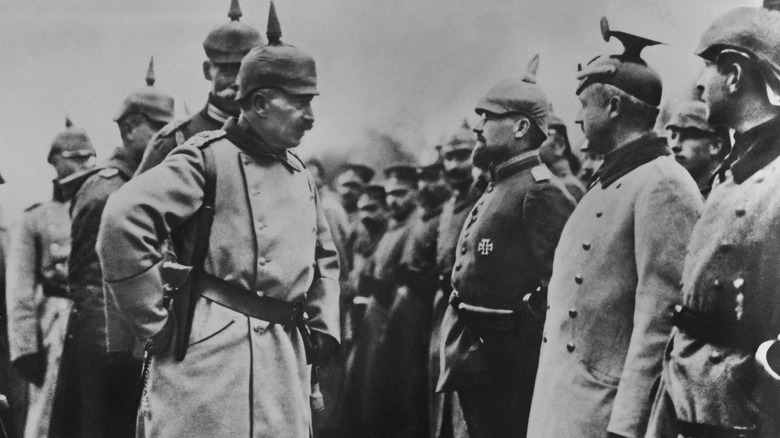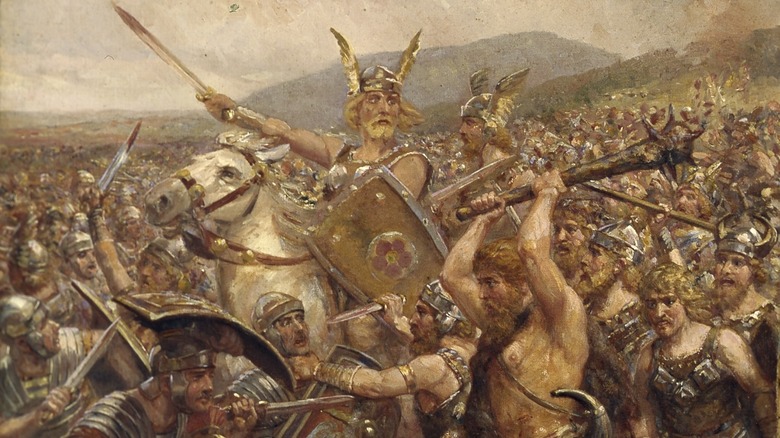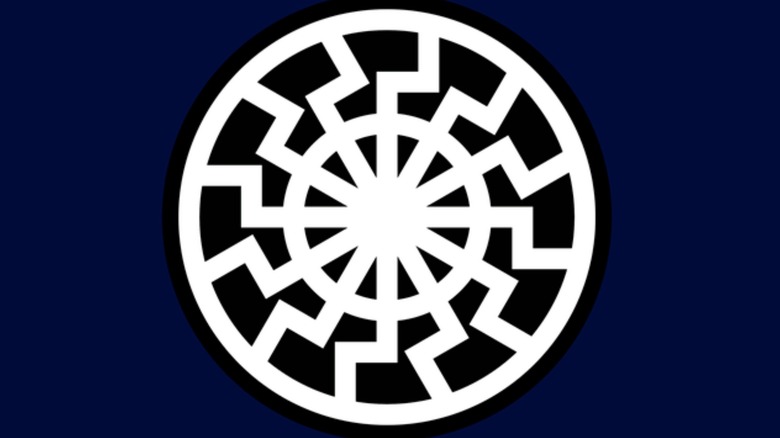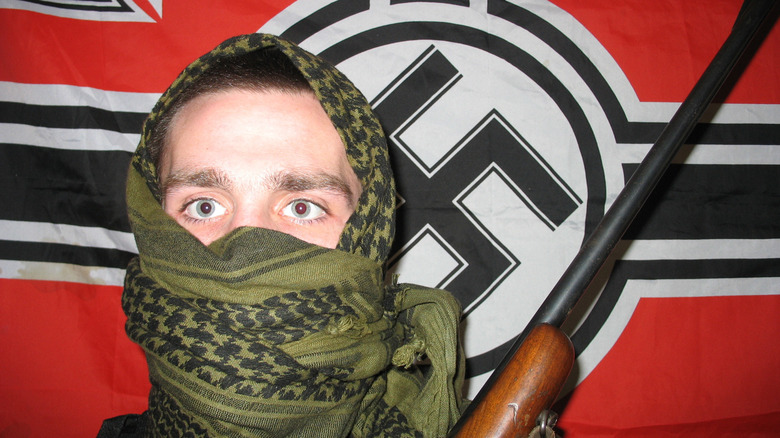The Pagan Origins Of The Infamous Nazi Black Sun Symbol
For those of a certain age, "Nazi plus mystical mumbo-jumbo" equals only one thing: Indiana Jones. Two out of Indy's original three movies involved the world's most unrealistically athletic professor battling the "armies of darkness" (per Quotes) over-mythologized Christian artifacts: the Ark of the Covenant and the Holy Grail. There were those melty-faced Nazis, some ark ghosts, an invisible bridge, and even a knight from the Crusades. It makes for some fantastic, ridiculous storytelling. But beyond such tales, is there any truth to the Nazi preoccupation with the mystical and the occult?
The short, big, whopping answer is — yes. Germany's Third Reich, the tyrannical World War II political regime not exactly known for its sanity, was frothingly obsessed with the occult. That being said, some cultish stories regarding Adolf Hitler, SS leader Heinrich Himmler, and other Nazi party members are downright silly or blatantly apocryphal. As Big Think outlines, these include a secret Nazi society based on a 19th-century work of fiction centered on telepathic, subterranean, supernatural beings called Vril-Ya. And yet, other tales regarding Nazi beliefs sound even more outlandish but are actually true. One of these involves Himmler's personal occultist, Karl Maria Wiligut, developing a religion centered around Germany circa 228,00 BCE, when Earth "had three suns and was populated by giants, dwarfs, and other mythical creatures."
Comparatively, the Nazi black sun symbol, aka the "sonnenrad," comes across as downright underwhelming. Even so, it was a piece of propaganda that the Nazis happily leveraged toward their own ends.
Norse influence over ancient Germany
The sonnenrad was inspired by Norse myth, but doesn't come from it directly. To refresh the reader, Norse myth — stories of Odin, Thor, Loki, Valhalla, Yggdrasil the world tree, etc. — originated in modern-day Scandinavian countries: Norway, Sweden, and Denmark. From about 800 – 1050 CE (via the Museum of Denmark), Vikings from Scandinavia traveled, raided, and traded out to Russia and the Baltics, west to Iceland, Greenland, and North America, and down to England, France, and yes, Germany. While they weren't always the kindest of folks, they and their culture left permanent, lasting impressions.
Back then, Germany — dubbed "Germania" by the ancient Romans (via Germania Mint) — was a loose confederation of tribal kingdoms, much like the rest of Europe. Around 772 CE, as the Metropolitan Museum of Art overviews, legendary Frankish king Charlemagne campaigned in the region to consolidate power, particularly in the name of the Catholic Church. He became the first Holy Roman Emperor in 800 CE. Come 962 CE, the Holy Roman crown passed to Otto I, king of Saxony, an area of northern Germany. Hundreds of years prior in the 5th and 6th centuries, Saxons had already emigrated to England and given rise to people of Anglo-Saxon heritage, via the British Library.
During this entire era of Viking contact, Norse influence seeped into Germany in a way stronger than other regions. Even the earliest mythological writings we have from Germany are written in Old Norse (via Britannica).
Scapegoats and national myths
Norse mythology stewed in Germany for over 1,000 years until World War II's onset in 1939. During that time, German culture at large came to adopt and admire aspects of Norse paganism: strength, resolve, clarity of mind, determination, etc. It's this exact ethos that Hitler and the Nazi party exploited during their rise to power to manipulate the German people. But without World War I, we wouldn't have wound up with the Nazis at all, let alone images like the sonnenrad.
Back in 1914, Germany egged on their allies to the east, the Austro-Hungary Empire, to seek retribution for the assassination of Austrian Archduke Franz Ferdinand by invading Serbia. As Imperial War Museums explains, German officials had grown afraid of the alliance between France and Russia and wanted an opportunity to assert dominance in the region. When World War I ended, Germany was on the losing side with 7 million dead (via Facing History), a broken economy, and international humiliation at the signing of the Treaty of Versailles. With all their ambition thwarted and their pride obliterated, the stage was set for the rise of the National Socialist German Worker's Party (Nazi) in the 1920s and '30s, as History explains.
At the same time, the "stab-in-the-back myth" arose in Germany, blaming sabotage from within as the chief cause of losing World War I. And the prime perpetrators? Jews, as the Anne Frank House says.
Nazi wartime propaganda
The Nazis incorporated Norse iconography into their lexicon of propaganda and self-mythologization to spread the notion of Germany being connected to a deep lineage of nigh-mystical superhumans bound to rule the world. Countless Nazi propaganda posters from World War II analogize Nazis to Vikings, as the University of Wisconsin's journal on Scandinavian Studies, The Cross Section, explains.
Nazi propaganda minister Joseph Goebbels drove the Nazi's Norse-leaning pagan appropriation in a truly obsessive way. One Nazi poster superimposes an SS troop with a helmeted Viking, while another depicts a Nazi soldier standing on a Viking longboat and wearing something that looks like chainmail. Another depicts a "god-like Norwegian" defending Germany against "our country's enemies," while another shows a Viking sword plunging into the red fur of Fenrir wolf, a character from Norse myth set to devour both the sun and Odin in Ragnarok, the final battle against the gods; Fenrir represents Russia in this case. The SS even had divisions titled "Wiking" and "Nordland," and used Norse runes, Scandinavia's ancient writing system, in their vie to appeal to new recruits. Even these examples account for a mere fraction of Nazi Germany's overall Norse obsession.
Add to this Hitler and Himmel's aforementioned single-minded preoccupation with the occult, astrology, the supernatural, parapsychology (described in depth on History Net), and it becomes clear that the sonnenrad, the Nazi "black sun," was just one image amongst countless.
A sun wheel with sowilo spokes
The Nazi sonnenrad ("sun wheel" in German) is a variation on sun wheels, solar crosses, wheel crosses, etc., found throughout not only pre-Christian Europe, but through the Asian continent, including India, and also North America, via Symbol Sage. Other examples include what Irish-Americans might wear around their neck, the "Celtic cross," symbol of the Celtic god of thunder, Taranis. The Nazi swastika is another variation on a sun wheel, but lifted directly from Buddhist, Hindu, and Jain iconography, as the BBC describes. "Swastika" is the Sanskrit word for "well-being," and to this day can be found at Buddhist temples throughout countries such as Thailand, Vietnam, and Japan.
The earliest sun wheel relates to the Norse god Odin, except it's a simple circle with a plus sign in the middle. The Norse word for this symbol, "kros," is where we get the word "cross" from in modern English. But because it apparently wasn't enough for the Nazis to just copy-paste Odin's cross like they did the swastika, the sonnenrad was embellished with twelve spokes that reflected the construction of the General's Hall in Nazi-occupied Wewelsburg Castle, as Learn Religions explains. Hans Himmler bent the spokes when designing the sonnenrad because it made each spoke look like the Norse "sowilo" rune. Sowilo is one of the 24 oldest runes, the Elder Futhark set, and represents the sun that grants life to the world. To the Nazis, the sun at the center represented the party leader, Hitler.
Shedding Nazism's legacy
There are other non-Norse-related aspects to the sonnenrad, as well. Even though the sonnenrad's twelve spokes connect to the twelve Norse Aesir gods, of which Odin was one, they also relate to King Arthur's twelve knights of the round table, the twelve gods of Mt. Olympus, and Jesus' twelve disciplines, via Learn Religions. Hans Himmler, in fact, named two of the rooms in Wewelsburg Castle "Konig Artus" (King Arthur) and "Gral" (Grail). The SS itself was also split into twelve branches, and there were twelve seats against the wall in a secret meeting area of Wewelsburg Castle with a depressed floor dubbed the "crypt" or "vault."
Suffice it to say, all such Nazi cherry-picking of world traditions, Norse paganism included, is no mark on any original belief. And yet to some, Norse mythology has been permanently tainted by its contact with Nazi Germany, same as the Buddhist, Hindu, and Jain swastika symbol. To this day, neo-Nazis sometimes try to wield Norse iconography, to which Icelandic Ásatrú high priest Hilmar Hilmarsson told the Atlantic, "I think it's obscene." Ásatrú, it should be noted, is a Norse revivalist religion based in Iceland that seeks to adapt old, pre-Christian ways for modern times.
It bears remembering that the Nazi attraction toward Norse myth reflected deep-seated insecurities and a sense of weakness regarding Germany's identity following World War I. This can help us understand why they drew inspiration from a tradition far more long-lasting and potent than theirs.
